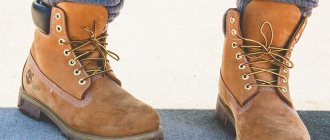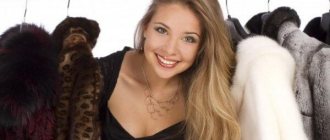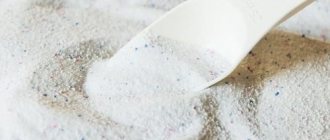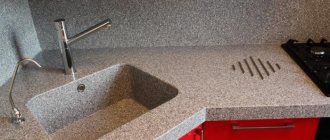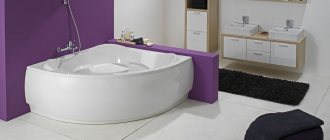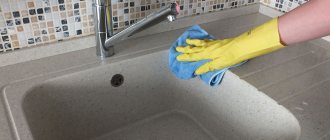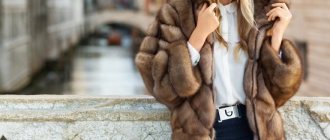And among people there are more copies than originals.
Pablo Picasso
Modern industry, using the latest technologies, is capable of producing artificial furs that are practically indistinguishable from the fur of some types of animals. How to spot a fake, how to identify it using improvised means?
The technologies of modern light industry have reached such perfection these days that, when buying a fur coat, we can no longer be completely sure that it is made of natural fur. Ideal imitations of fox, mink, beaver, muskrat, seal, and raccoon filled the counters and fitting rooms of fur salons. However, some brands have deliberately abandoned the use of natural fur in the manufacture of their models. This is due to the “green” movement, which has serious weight in society. Let's look at faux fur, weigh the pros and cons of using this material and purchasing outerwear made from it, and draw our own conclusions based on this.
What's warmer: flannelette or wool?
Flannelette material is obtained by twill or plain weaving. ... This is always a natural material, but its properties can change. The higher the wool content, the warmer the fabric.
Interesting materials:
Which zodiac sign suits mother of pearl? Who wants Nastenka? Anyone know how to do it right? Who needs a 2nd personal income tax certificate? Who needs temporary registration in Moscow? Who does the clerk report to? Who does the Federal Bailiff Service report to? Who is suitable for sulfate-free shampoos? Who is burgundy color suitable for? Who is the Leshmaker profession suitable for?
What is faux fur made from?
Currently, faux fur is manufactured in four varieties: woven, knitted, glued and stitched. Regardless of the type, it consists of two main components - the base and the pile.
Woven fur is produced using a technology in which two base fabrics are connected (weaving process) with a pile thread, which is subsequently cut. The knitting method involves knitting the pile into the warp using special circular knitting machines.
The stitching and adhesive methods involve making the base and pile separately, after which they are combined. If the adhesive method is used, the pile is glued to the base, and with the stitching method, it is stitched through it.
Pile is made from various synthetic threads, for example, viscose, polyester, other polyamide, polyester and acetate threads. When making the base, cotton is most often used with the addition of synthetic fiber to give the fabric greater strength.
Artificial fur
What to wear with winter leather boots?
With a short, wide-cut fur coat with a flared skirt, women's boots with fur, high, with a zipper, or ankle boots with a fur trim are suitable.
With a leather jacket, which has fur trim at the cuffs, trousers made of coarse material with a simple type of model are usually worn. An ankle boot with short fur without zippers or fasteners on the side, but with lacing at the front, would be suitable for this selection of clothes.
How to distinguish popular types of furs
An unscrupulous seller may pass off a cheaper analogue as an expensive material. For example, dyed beaver is very similar to nutria, and chinchilla can be replaced with chinchilla rabbit fur. To prevent this from happening, it is useful to know the following facts.
Mink
The most popular fur, so it’s very easy to run into a fake. Usually, rabbit, marmot or faux fur is used to fake it, because the sheared version is very difficult to distinguish.
Therefore, when purchasing, you should consider the following features:
How to check in different ways
There are several ways to quickly distinguish natural fur from synthetic fur.
How to determine by touch
Natural wool always feels smooth and soft to the touch. If you run your hand over it, the villi will quickly return to their previous position. You can squeeze the product in your palm and then release it. Natural flesh will instantly return to its previous position, as it has a high degree of elasticity.
You can also notice that this fur is a little itchy. If you run your hand over it, the fibers will pass through your fingers, as if you were petting a cat. It is worth paying attention to the undercoat - it should be quite thick and soft. In addition, the natural material is always a little cool to the touch, and has a beautiful shine when exposed to sunlight.
Don’t forget that the fur of different animals feels different to the touch. Mink hair is quite hard, while beaver hair is very fluffy. The silver fox can be recognized by the presence of three different colors on each hair. And its skin is soft and warm to the touch.
Fire test
Another way to check the naturalness of fur is to set it on fire. This must be done carefully by pulling out a few fibers and bringing the fire to them. When real animal fur is burned, an unpleasant smell of burnt hair will be felt. In this case, the material will burn, leaving behind only ash.
Synthetics will begin to melt, and as a result will turn into a ball of plastic. The process produces a very unpleasant chemical odor. The complexity of this method is that not every seller will allow this experiment. Therefore, you can determine the quality by fire only after purchase.
Pierce with a pin
A pin or needle is another simple method for determining whether the fur you are looking at is real. Use the tip of the tool to carefully pierce the product. In the case of animal skin, the needle will be very difficult to enter, but the artificial fabric base can be pierced quite easily. You also need to pay attention to the hole that remains after the experiment. If you pull the skin in different directions, it should not increase.
Basics test
You can verify its naturalness by carefully examining the base and spreading the hairs apart. In the case of faux fur, it is always fabric, stretchy, you can see threads on it, and this immediately catches your eye. Natural products are distinguished by a smooth leather base. It is also worth paying attention to its color. A high-quality real animal skin will be white or very light, but if it is colored, then most likely it has been dyed.
Important: high-quality fur does not require painting. Often, manufacturers dye and cut it in order to hide any defects.
As you can see, you can always check whether the fur in front of you is natural or artificial. But every year it becomes more and more difficult to distinguish them. Modern technologies allow manufacturers to imitate natural materials as efficiently as possible, which causes many difficulties when choosing a product. In order to correctly identify all the differences and purchase a truly high-quality fur coat or sheepskin coat made of natural fur, you need to be very careful and use all the above recommendations.
What should you pay attention to?
When choosing a fur product, you first need to study the label. In most cases it is on the wrong side. The tag must indicate the materials used for manufacturing, composition, serial number, country of origin, manufacturer's address and other contacts. All inscriptions must be legible. Sometimes the label also includes care instructions.
In addition, products made from natural fur are in most cases branded, and therefore, when you see the brand name, you can safely search for information about the manufacturer on the Internet.
We should not forget that real fur cannot be cheap, because the production of such products requires high costs. Therefore, the low cost of a mink coat or boots with sheepskin should alert the buyer.
Also, when deciding to purchase a natural product, you should pay attention to its weight. Animal wool will always be slightly lighter than synthetic material. It is also necessary to take into account the presence of odor - there should not be any.
You should not believe sellers who say that the product has been sitting for a long time and therefore lint is falling out of it. Natural hairs should not fall out. Otherwise, we can talk about the fur being synthetic or that the animal could have various diseases.
Looking at the back of the product, you will notice that there are stamps on the skin, usually purple, and pieces of leather are sewn with small seams.
Differences between artificial and natural fur
Faux fur is inferior to natural fur in many ways. But it has huge advantages - it is low cost and excellent relations with the Green Party. Otherwise, he is losing ground a lot. It is considered “cold” fur due to its low ability to retain heat. He cannot withstand the cold for a long time, the person begins to freeze. High susceptibility to contamination makes caring for a faux fur product a pain. Constant cleaning not only becomes tiring, but also leads to a deterioration in the appearance of the product. Faux fur is afraid of water, especially if it is made using adhesive technology. When wet, fabric is more susceptible to deformation than the natural skin of a fur-bearing animal. As a consequence of these shortcomings, the service life of artificial fur is short. No product made from it will be worn for more than four seasons.
fur hairs
The method of checking hairs is truly extreme - arson. You need to pull out a few hairs and, using an ordinary lighter or matches, set them on fire. Natural fur burns out quite quickly, leaving an unpleasant smell of burnt hair. The artificial material does not burn, but rather melts, giving off the smell of burnt plastic. I must admit, this method is considered one of the oldest and most effective. Natural fur fibers taper at the end, while faux fur fibers are square in shape. It is this difference in structure that gives natural fur its smoothness and softness.
Characteristics of natural fur
To understand whether the fur you are being offered to buy is real, you need to understand the types and properties of natural animal fur. Each type of fur is unique in its structure and has individual characteristics.
- Mink . The most sold and popular fur is mink fur. Expensive fur has the softest and silky structure. The mink pile is perfectly smooth and even - this gives each sewn product elegance and sophistication.
- Sable . The next luxurious and elegant fur is sable fur. Sable products are incredibly expensive and not everyone can afford such wealth. The structure of the fur is unique, and if you even once touch sable clothing, you will not confuse this feeling with anything else. Despite modern trends in dyeing and cutting fur products, famous designers prefer not to spoil the natural beauty of fur.
- Arctic fox . The fur of the Arctic fox is long-haired, fluffy and light. Products made from it are luxurious, although they are budget-friendly compared to mink and sable. In nature, there is white and blue scribe; all other shades are artificially colored.
- Fox . The fur of the unique black and brown fox is very valuable and attractive. The density, fluffiness and coziness of this fur attracts attention. The fur is very warm, wear-resistant and practical. And the shade looks advantageous and is suitable for creating all kinds of fur items.
- Rabbit. Rabbit fur attracts with its low cost. Despite the budget, this fur is practically in no way inferior in its wear-resistant qualities and has a varied palette of shades. It is with the help of this fur, namely its cutting and dyeing, that manufacturers counterfeit expensive products.
Fur coat made of natural rabbit fur - Chinchilla . The incredibly light and densely padded fur belongs to the chinchilla. The color of the fur is unique, it shimmers and smoothly changes from dark gray to a bluish tint from the back to the sides, and on the belly it is snow-white. This fur is very valuable, and products made from it are expensive.
- Marten . Marten fur looks a little like sable. However, the marten's spine is thicker and denser, and the cover itself is harsh. This fur is perfect for sewing long fur coats, as well as handbags, hats, collars and other accessories. The advantage of this fur is its natural wide palette, from light gray to dark brown.
Let's sum it up
To choose a genuine fur item, you need to be very careful and have time. You should not buy the first product you come across and succumb to the persuasion of sales consultants. Remember, you are buying an expensive item and most likely not for one year. [Total: 3 Average: 2.3/5]

